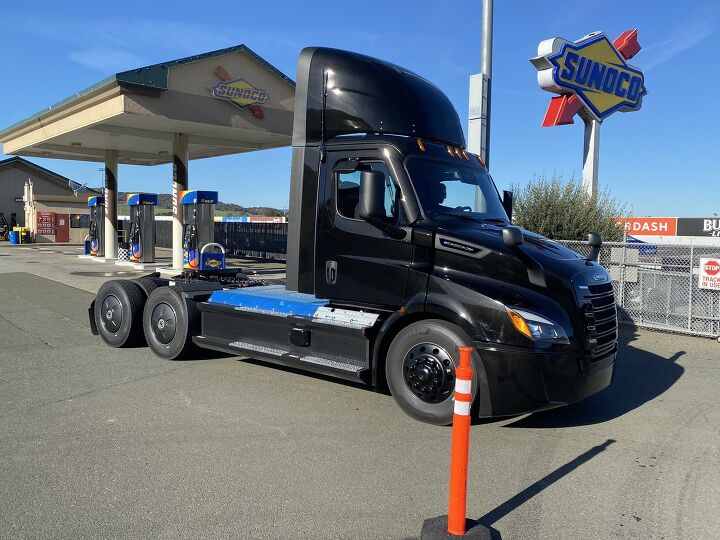
If you’re interested in a career in automotive journalism, here’s a piece of unsolicited advice – don’t get in the passenger seat of a Lucid Air Sapphire with the car’s development engineer for hot laps of a major racetrack shortly after eating lunch.
If you do, you might find yourself burping unprofessionally as the driver slides through the esses.
Don’t get me wrong, it’s a lot of fun to ride shotgun with pro drivers when they’re going around a famed racetrack like Sonoma Raceway at speed. But normally I try to follow the same rule used for swimming – wait until 30 minutes after eating.

As fun as my ride in the Lucid was, it was a small part of a larger event put on by tire maker Michelin – one meant to give assembled media and analysts insight into the company’s sustainability plans. Other aspects of the event included a chance to chat fuel cells with Symbio, drive an electric-motor-powered big rig on the racetrack grounds, and a few laps of our own in new cars to get a sense of how Michelin’s newest rubber works. Well, two new cars – a Porsche Taycan and Mercedes-Benz EQS – and an aging Ford Explorer.
(Full disclosure: Michelin paid for my flight, hotel room, and meals so that I could attend the event.)

There was a lot going on last month at what was once called Sears Point. We spent our morning listening to key Michelin execs talk about sustainability when it comes to tires and other aspects of the business, and sat down with some of these same folks for interviews later. The rest of our day was given over to the events listed above.

Michelin president and CEO Alexis Garcin told us that the company is all about three P’s: People, profit, and planet. To that latter end, the company has a goal of having all its tires be made of 40 percent renewable and recycled materials by 2030, and 100 percent recycled/renewable by 2050.
If Michelin can achieve that, it claims that EVs shod with its tires will make up to 40 miles more range. When I pressed Michelin on if the company could hit its targets, Cyrille Roget, Michelin’s Scientific and Innovation Communication Director, said the company was “very confident” about 2030 but 2050 was more of an ambition. One challenge, he said, is to overcome negative consumer perceptions about recycled content.
Michelin also was happy to point out that its newest tires are already using 42 percent renewable/recycled materials. Fun fact, by the way – tires, whether they are sustainable or not, are made of 200 different materials.

Michelin won’t be selling sustainable tires solely to consumers – there will be fleet users, too. Pierluigi Cumo, VP of Michelin Business to Business Products for Michelin North America, told me improvements in mileage, rolling resistance, and how often the tires need to retreaded will be part of the sales story as Michelin works with fleets. That will be key, since demand has cratered recently after being unusually strong during the pandemic.
Roget also pointed out that consumers are more sensitive to retail price, while fleet customers care about lower rolling resistance and the fuel-economy savings that would follow.
You might be wondering why Michelin is making this push – is it in response to regulations? Roget says no, since regulators need to first define what constitutes “sustainable” before they can come up with regulations. Garcin also told us that OEMs are targeting a more sustainable tire for the cars and trucks they sell.

When it comes to sustainability, it’s not just about tires – Michelin is working on Wisamo, which is a sailing system for cargo ships.
This isn’t “The Truth About Cargo (Ships)”, however, so let’s take it back to cars and tires. We got the seat time in the EQS, Taycan, and Explorer to see how well this new rubber would help us stick to the pavement.
Obviously, each vehicle’s handling characteristics and abilities are impacted by more than just its tires. The Taycan was going to stick well no matter what rubber it was shod with, and the Explorer was similarly going to be a handful. Without a back-to-back comparison, it was hard to definitively state these Michelins were improved over tires that aren’t so sustainable, but they were definitely sticky enough for a few laps of track duty at 6- to 7-tenths effort. Even in the Explorer.
The Daimler Freightliner eCascadia I drove was shod with Michelin XLEZ+ tires, but tooling around at 10 mph on racetrack access roads isn’t much of a test – I simply had fun living out a childhood dream.

By the way, the Lucid mentioned above wore Michelin Pilot Sport 4 S rubber.
Sometimes the word “sustainable” conjures up an image of compromise. While our tire test gave us only a small taste of what these tires could do, it certainly seems that performance will not be sacrificed for sustainability, at least not with these Michelin tires. We’ll reserve more judgment until we can do a more comprehensive test, but if what we experienced is representative, those who want sustainability without loss of performance may be able to have their cake and eat it, too.
[Images © 2024 Tim Healey/TTAC.com, Michelin]
Become a TTAC insider. Get the latest news, features, TTAC takes, and everything else that gets to the truth about cars first by subscribing to our newsletter.

